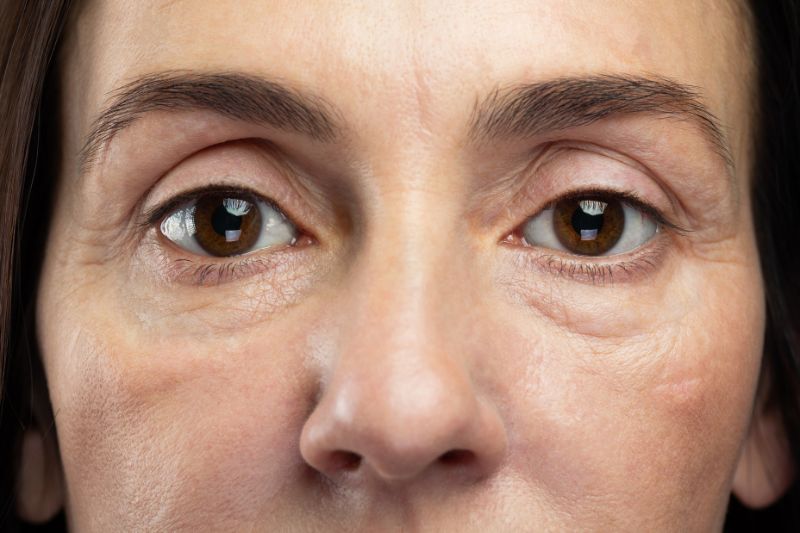Ageing is inevitable, but the thin, delicate skin around the eyes means the signs of ageing reveal themselves much faster than other areas of the face. It’s estimated that the skin is 40% thinner around the eyes. Here are the five most common signs of eye area ageing and the appropriate solution.
Sagging on the upper eyelids
As the skin on the upper lids becomes thinner and less elastic and the underlying tissues succumbing to gravity, the heavy, stretched skin can make the eyes appear hooded, with the upper eyelid crease lost. In more severe cases, this sagging skin can even obscure vision.
An upper eyelid blepharoplasty restores a more youthful, refreshed appearance by making an incision along the eyelid crease to remove excess skin, fat and muscle to smooth the upper lid. If there is eyelid hollowness, these tissues can be repositioned. The scar is usually well hidden in the eyelid’s natural fold and will be undetectable when healed.
Undereye bags
Bags under the eyes are a common ageing concern and occur when the tissue supporting the eyelids starts to weaken. As well as skin sagging, the fat pads underneath the eyes push forward.
A lower eyelid blepharoplasty tightens and repositions these supporting tissues and fat pads and removes any excess skin and fat. The incision is made either under the eyelash line or through the inside of the eyelid, known as the transconjunctival or ‘scarless’ approach.
Brow droop
As we age, sagging facial tissues cause the position of the eyebrows to lower, loose skin to appear on the forehead and hooding of the upper eyelids. Patients often complain it makes them look tired or angry. A brow lift can reverse these signs of ageing by tightening the tissues on the brow and opening up the eye area.
There are several brow lift techniques. During your consultation with Dr Nick Koutroumanos, he will advise you on the optimal approach, considering your current eyebrow position, facial structure, hairline and desired results. A brow lift is often combined with an upper eyelid lift for optimal results.
Tear troughs
The descent of the mid-face causes a tear trough deformity. Typically, the youthful face has smooth contours, but a deep crease can appear between the lower eyelid and upper cheek due to volume loss in the mid-face. Patients often complain that it makes them look unduly tired. Weight loss and stress can cause a tear trough deformity to appear more pronounced.
A lower blepharoplasty can improve the appearance of the tear trough by repositioning fat tissue under the eye to produce a smoother contour between the undereye and upper cheek. Temporary hyaluronic acid dermal fillers can also smooth out the crease.
Dynamic wrinkles
Our eyes are our most expressive feature, and our facial muscles’ constant contraction and relaxation as we frown, squint or smile result in frown lines and crow’s feet. The ageing process and damaging lifestyle factors such as sun exposure or smoking can accelerate their development.
The most effective treatment for these lines is neurotoxin injectables that work by softening the actions of the orbicularis oculi muscle. By relaxing the contraction of this muscle, the lines around the eyes are softened and smoothed.
“I spent several days researching Ophthalmologists in the UK before booking an appointment with Dr. Nick Koutroumanos to discuss an Upper Blepharoplasty. There are many factors to take in to account, reviews being just one. I was somewhat panic stricken by the idea of a knife+eyelid experience under a local anaesthetic. As it turned out it was much less traumatic than going to the dentist. I was allowed to yap a little throughout the op which helped calm, enabling me to mentally (!) liken it to a hairdressers appointment. Nick is very personable, reassuring and probably one of the best eye surgeons.
I am totally elated with the results. He achieved exactly what he/I wanted him to, fixing some assymetry as well as restoring them to how they looked a decade earlier, better than in fact. Even after two weeks the scarring is so minimal that if it did not improve from now (which it may ) it does not bother me. Very happy.”
For more advice on the appropriate procedure, a consultation with an oculoplastic surgeon is essential. While a plastic surgeon is trained in the reconstruction of the entire body, oculoplastic surgeons specialise in the anatomy of the upper third of the face and the functioning of the eye.
Call +44 2045316760 for an appointment with Dr Nick Koutroumanos to discuss your ageing concerns.







